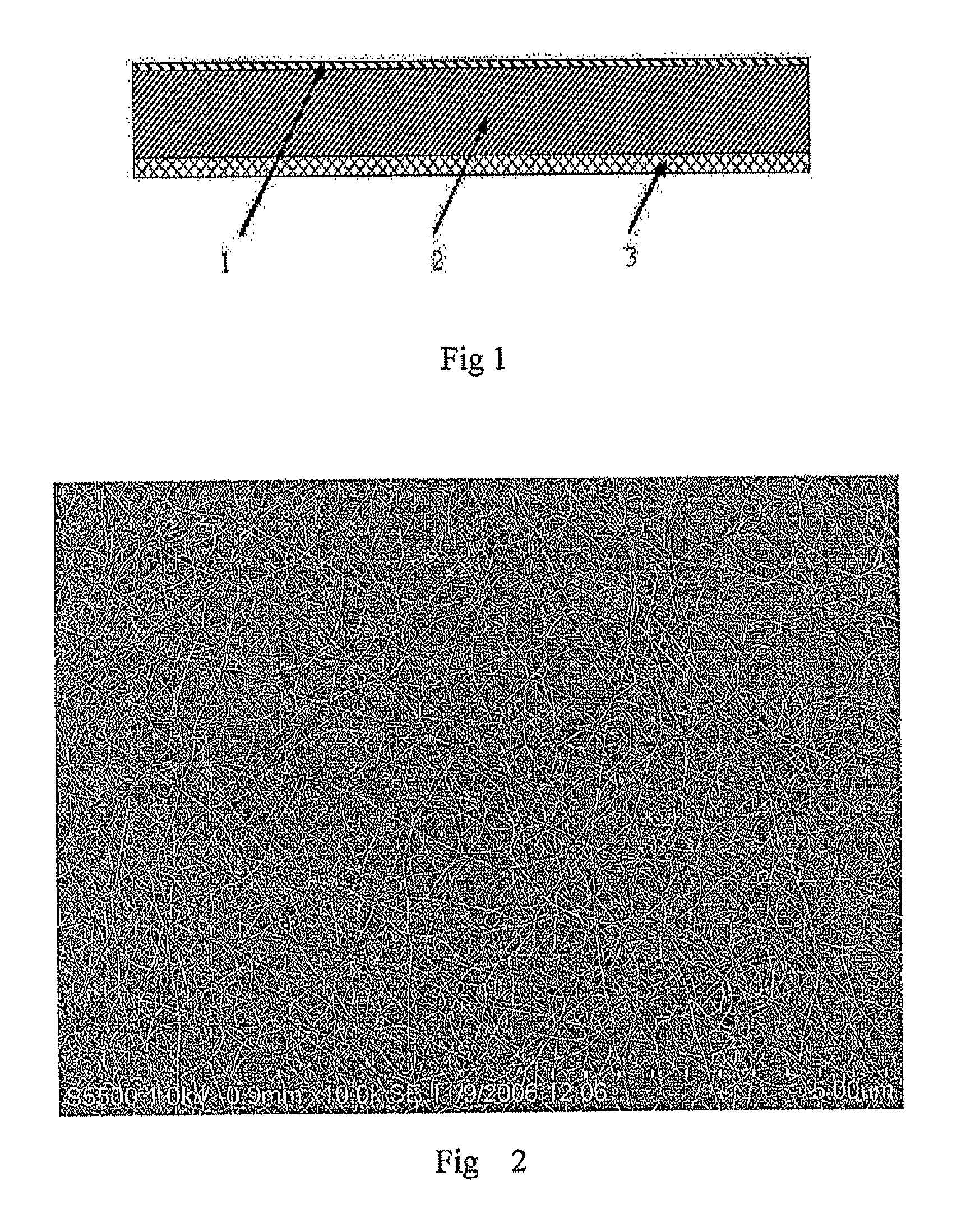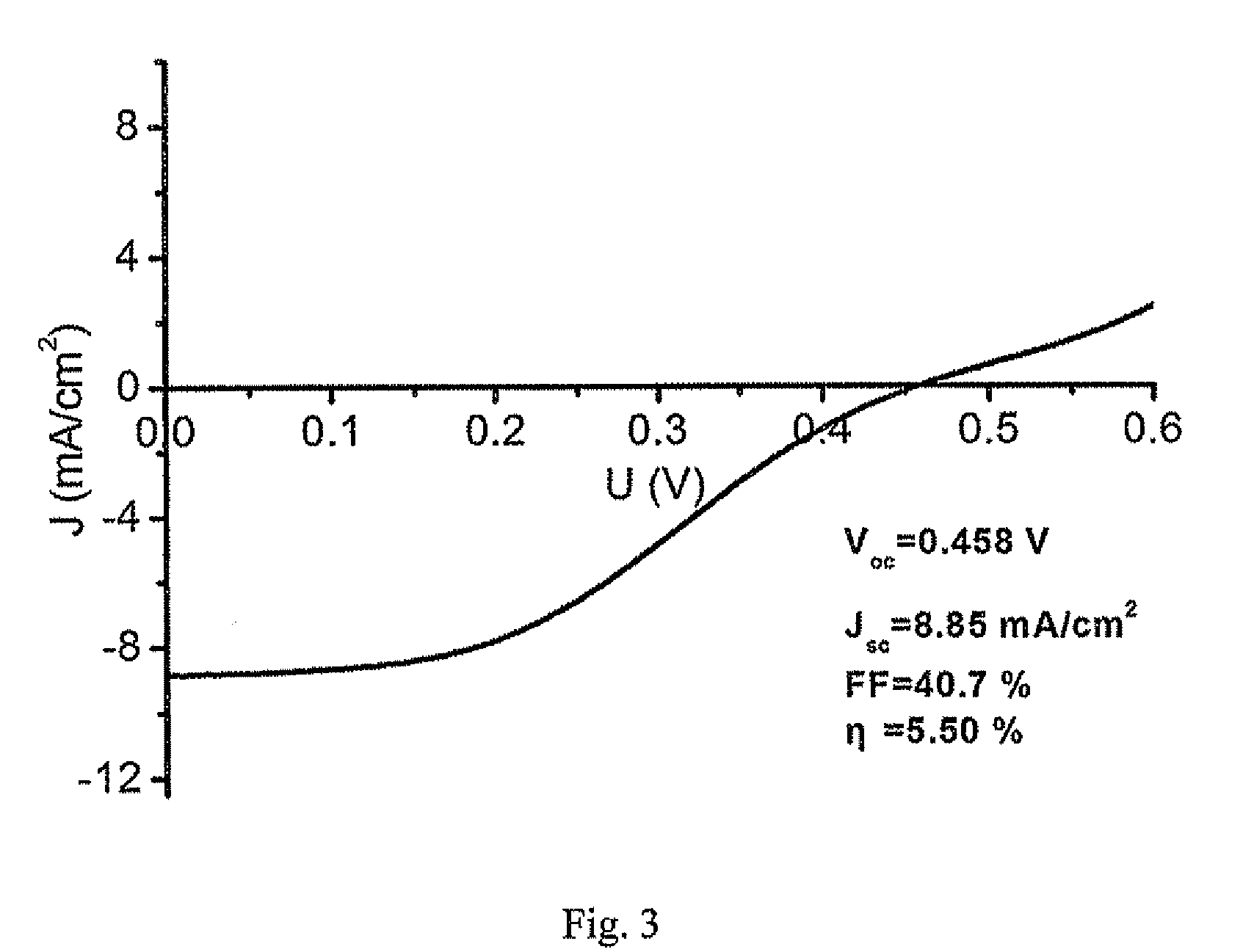Carbon nanotube film based solar cell and fabricating method thereof
a carbon nanotube film and solar cell technology, applied in the field of solar cells, can solve the problems of low conversion efficiency of commercially available solar cells in china, low conversion efficiency of polycrystalline silicon based solar cells, and low conversion efficiency of theoretical values, etc., to achieve strong absorption, low cost, and simple production
- Summary
- Abstract
- Description
- Claims
- Application Information
AI Technical Summary
Benefits of technology
Problems solved by technology
Method used
Image
Examples
example 1
[0021](1) Onto one side of silicon substrate 2, Ti / Pd / Ag metal layers were evaporation uniformly successively, and used as the back electrode 3 of the carbon nanotube film solar cell, which was then led out by a wire;[0022](2) After purification, the double walled carbon nanotube in the form of aggregation was placed into deionized water, onto which ethanol solution was further added, then the double walled carbon nanotube spread into a film having a thickness of 100 nm;[0023](3) The spread double walled carbon nanotube film was transferred to the other side of silicon substrate 2 on which back electrode 3 was not prepared;[0024](4) The double walled carbon nanotube film was dried under infrared lamp, so that the double walled carbon nanotube film contacted with silicon substrate tightly. The double walled carbon nanotube film was taken as the upper electrode of the solar cell, which was then led out by a wire.
[0025]It could be seen from FIG. 2 that the thus prepared carbon nanotube...
example 2
[0027](1) Onto one side of silicon substrate 2, Ti / Au metal layers were evaporation plated successively, and used as the back electrode 3 of the carbon nanotube film solar cell, It was led out by a wire;[0028](2) After purification, the single walled carbon nanotube in the form of aggregation was placed into deionized water, onto which acetone solution was further added, then the single walled carbon nanotube spread into a film having a thickness of 50 nm;[0029](3) The spread single walled carbon nanotube film was transferred to the other surface of silicon substrate 2 on which back electrode 3 was not prepared;[0030](4) The combined body of the obtained single walled carbon nanotube film obtained in step (3) and silicon substrate in a drying oven, the temperature of which was kept under 50° C. for 3 hours, so that the single walled carbon nanotube film contacted with silicon substrate tightly. The single walled carbon nanotube film was taken as the upper electrode of the solar cell...
example 3
[0032](1) Onto one side of silicon substrate 2, Ti / Pd / Ag metal layers were evaporation plated successively, and used as the back electrode 3 of the carbon nanotube film solar cell. Then it was led out by a wire;[0033](2) The thus prepared aligned carbon nanotube was ultrasonic treated for 1 hour, so that it was dispersed thoroughly;[0034](3) The spread single walled carbon nanotube film was transferred to the other surface of silicon substrate 2 on which back electrode 3 was not prepared, obtaining a carbon nanotube film 1 having a thickness of 200 nm;[0035](4) The carbon nanotube film 1 was dried under infrared lamp, so that the carbon nanotube film 1 contacted with silicon substrate tightly. The carbon nanotube film was taken as the upper electrode of the solar cell. Then led it out by a wire.
[0036]Solar cell conversion efficiency measurement was taken under irradiation of solar energy stimulator having an intensity of 30 mW / cm2, and the conversion efficiency obtained was 3.5%.
PUM
| Property | Measurement | Unit |
|---|---|---|
| thickness | aaaaa | aaaaa |
| axial resistivity | aaaaa | aaaaa |
| short circuit current | aaaaa | aaaaa |
Abstract
Description
Claims
Application Information
 Login to View More
Login to View More - R&D
- Intellectual Property
- Life Sciences
- Materials
- Tech Scout
- Unparalleled Data Quality
- Higher Quality Content
- 60% Fewer Hallucinations
Browse by: Latest US Patents, China's latest patents, Technical Efficacy Thesaurus, Application Domain, Technology Topic, Popular Technical Reports.
© 2025 PatSnap. All rights reserved.Legal|Privacy policy|Modern Slavery Act Transparency Statement|Sitemap|About US| Contact US: help@patsnap.com



